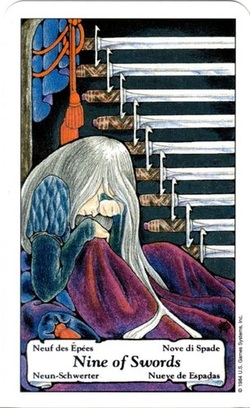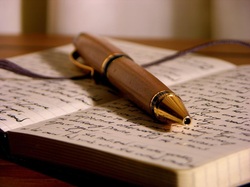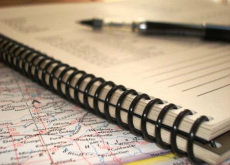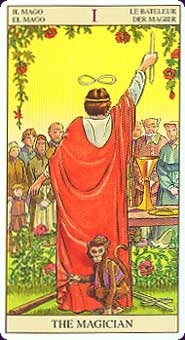 Well, aside from the "hero with a presumably hopeless cause" thing, they're both archetypes. From Anansi to Merlin, from Don Quixote to Jack Sparrow, archetypes are characters that are larger than life—broad "types" that everyone can know and relate to. Famous figures like Carl Jung and Joseph Campbell spoke a lot about archetypes because they say a lot about human nature. Through the way we tell stories, we learn a lot about what's important to us, and how we view the world we live in. Archetypes become blueprints that we all can relate to, drawing us in based on how we live and what we want for ourselves. Few people feel they're exactly like Batman, Gotham City's brooding guardian, or that they have the roguish charm of Han Solo. But they can reflect on the powerful images those characters create when they're looking for inspiration about the kind of person they'd like to become. Tarot may have started as a card game. But the figures in that game—the Emperor, the Chariot, the World—are all images of ideas we can connect and relate to. This makes it a perfect tool for self-discovery. The way we tell the story of our lives is powerful stuff. When we choose the stories we tell ourselves and the world, we decide the images that help us reflect on our lives. Tarot's Major Arcana is where the most archetypical figures dwell. The Major Arcana provide images of many different figures and settings along a long road to self-development and enlightenment. The ideas about what they represent have changed over time and they're still changing. But finding out what those images mean to us tells us a lot about who we are. Try this exercise to take a look at the archetypes that inform your life: List three of your favorite characters from any story. Movies, comics, mythology— nothing is off-limits. If you want to list a religious figure you believe literally exists, that's completely fine too. Remember, we're looking at the stories that inspire us and help us grow.
Now look at your list of three figures. For each character, list the qualities that draw you to them the most. I'd suggest at least three things but you can keep going if you like.
When you've created your list, look at the characters and qualities that you've written down. Spend some time thinking about them. Are they male or female? Heroes or villains? Do you relate to them because of things from your own life? From the lives of people you love? How can you use their stories to inform and transform your own life?------ This blog post is an excerpt from my new course, Tarot Journeys: Of Mentors and Magic Wands. The course takes a look at the first six cards of the Major Arcana, and how they can serve as guides on our personal journeys. If you like what you see, give the course a look - and sign up to my list! I'll be sending regular updates about Tarot Journeys and all my other offerings, including a free giveaway coming up soon!
 There are a lot of eye-rolling cliches about how talking to yourself is a sign of some kind of instability, the first sign that you're "losing it." It means you're fragmented, freaking out, unable to "keep it together."
Personally, I think it's a great idea. And I keep on learning new ways to do it.
You know the old jokes in cartoons, when you get a look at a character's brain? There are all these little mini-selves running around, like highly specific Smurfs. 'Anger' sets his head on fire at the slightest insult. 'Love' is scattering flowers. 'Fear' is cowering in a corner, trembling at every little noise.
Of course, it's never that easy to pick specific things out. Emotions are complicated, wrapping themselves in layers and sometimes carrying two completely contradictory feelings at once. It can seem like a huge, frightening task to even sort through all your feelings, let alone pick them out and give them a face.
But maybe that's exactly what we need to do sometimes. Take a look at the complicated thought that's been hanging on to you for a while, keeping you blocked or sad or overwhelmed. Start picturing it as a person. What does it look like, and how does it dress? What's its body language? Does it have a name? Draw it, if you're artistic.
Set aside ten or fifteen minutes where you can sit quietly, undisturbed. Then turn in towards that feeling and have a conversation with it. Introduce yourself to it, and ask what it's doing there. Learn who it is, and make friends with it. Find out what it needs. See if you can transform it, and find some positive work for it to do.
Any kind of communication with yourself is just one more form of meditation. And the more we sort through and get to know ourselves, the more we're able to transform ourselves into stronger, happier people.
 When talking to a friend about some tough memories, she said something to me that I have the feeling is going to stick with me a long time.
"What's the story you're telling behind that?"
We all have stories, she explained. Not the stories that really happened, the ones that are actually a part of our history. But the stories we tell ourselves, the ones that come up in our memories and play tricks on us.
"I wasn't good enough, so I failed."
"Their lives are perfect; I wish I was like them."
"I ruined everything, and now they hate me."
Maybe, as an anxious or sensitive person, you actually say it in those words. Maybe you don't realize that's the way you see it, but you might as well be saying it in the back of your mind. Our lives go through a filter, where we see the circumstances as a play - and the ending is whatever we decide to believe about ourselves. And often, the impressions we leave are strong and can be unforgiving.
Look back over the stories you tell yourself, and find one that stands out as an old regret. Then rewrite it. Pick out the parts where you did well, and the parts where you could have done better. Then rewrite the ending. Create the final act where you release your pain, climb the next hurdle, prove yourself and believe you deserve it.
You're already writing your story. Empowerment just means consciously creating a new chapter.
 One of my favorite bits of advice about using the Tarot for daily guidance and growth comes from the book "Tarot Journaling" by Corrine Kenner. The book is a really extensive guide to using Tarot cards as a prompt for daily journaling, one of the best ways I know to both learn the cards and gain some insight into yourself.
The advice was this: if the card you draw doesn't seem to fit you or your situation, start writing about that. Write about how it doesn't fit you at all, about how it was a mistake to draw that card. Write about why you can't possibly learn from it. By the end of your writing, you'll see why it was the card you were meant to draw all along.
When we perform divination for ourselves, we're all at the risk of seeing what we want to see. We draw another card "just to be sure", or interpret things in the broadest possible terms. It's one of the reasons even Tarot readers get readings from others: sometimes we just can't be objective about our own situation.
But when our purpose in reading is to spiritually delve, to see what we can dig up within ourselves, it's important to understand that there really are no accidents. There are many, many paths to the heart. Sometimes, in discovering what doesn't feel right, you can make room for what does. Sometimes in asking the wrong question, you stumble how it leads to the right one.
It's an excellent lesson for life as well: don't wait for it to be the "right" moment. Keep going, do the work, and the road will lead you to the answers you're meant to find.
 There are hundreds of sites out there talking about how to read Tarot, and how each reader personally sees the cards. Personally, I love them all. They enhance my own insights and style, they make me a better reader.
But there's so much more the cards can do. Italo Calvino's book The Castle of Crossed Destinies has his characters unable to speak, telling their stories purely through Tarot images. The archetypes are so powerful, they can do a lot of speaking for us in the ways we least expect.
Here are five ways Tarot can be turned into a game or a creative tool.
- Cast your favorite characters into roles.
Think of your favorite piece of media - TV shows, movies, books. If they could fit into Tarot cards, who would they be? My nerdy little heart loves to do this with Disney characters, imagining Dumbo as the Fool, Bambi's mother as the Empress, and Doctor Facilier as a wicked, reversed version of The Magician.
- Create a storytelling Round Robin.
You can do this alone or in a group. It's a lot like campfire stories: after shuffling, one person draws a card, and says "There once was...a great and glorious hero, who drove a fearsome Chariot." (Just for an example.) Then the next card drawn continues the story: "One day this hero came across two children, giving each other gifts." See what comes out of the story you tell!
- Have an interview.
This is especially great to do if you're writing a book. Come up with a handful of questions for a character you're writing, and see what cards you draw for each question. Or reverse it - interview one of the Major Arcana about what they have to teach you, or their philosophy on life. You may be surprised at the new depths you find.
- Expand your vision.
One deck I need to get my hands on is the "Tarot of New Vision", a deck that takes familiar images from the Rider-Waite Tarot and turns them 180 degrees, so you can see a new perspective on the card. Imagine what's happening in the cards just offscreen, or behind the figure you see. Or look at one special detail in the cards, and zero in on it. How did the Magician receive his ouroboros sash? What's in the boats the figure in the Two of Wands is looking at? Write a journal entry or a story about it!
The best part of all this: while you use these games and story ideas to have fun, you're also learning to get closer to the cards, and be a better reader! See what new insights open up for you.
|





 RSS Feed
RSS Feed

